- What is Cloud Computing Architecture?
- Components of Cloud Computing Architecture
- Front-End Platform
- Back-End Platform
- Benefits of Cloud Computing Architecture
- Conclusion
- Frequently Asked Questions (FAQs)
Understanding Cloud Computing Architecture

Cloud computing is one of the most significant advances in technology, offering access to computing resources beyond the limitations of traditional on-premise computing. Such a paradigm shift moves away from conventional on-premise infrastructure towards scalable and flexible services that provide for ubiquitous data storage, processing and applications deployment of cloud services. Cloud computing constitutes an evolving network of virtualized assets, including servers, garages and networks, for inexpensive scalability and accessibility using business entities.
Read ahead to understand the essential elements of the structures that enable cloud computing, aka the cloud computing architecture.
What is Cloud Computing Architecture?
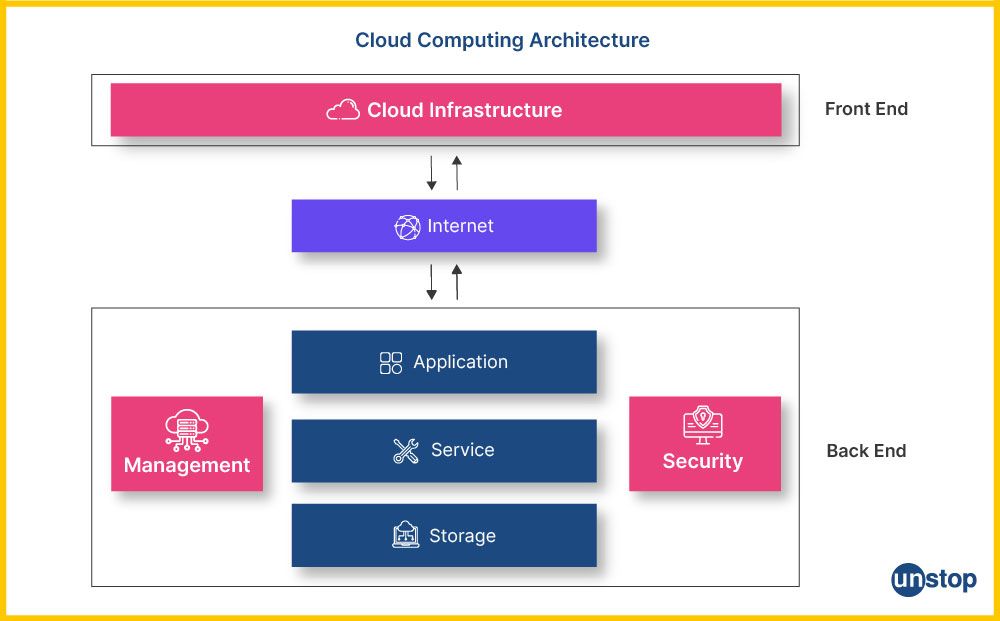
The term “cloud computing architecture” refers to the structural organization of elements within a cloud computing setting. This covers all the aspects of hardware, software, networking, and the services involved.
Take for example a public cloud such as Amazon Web Services (AWS). In AWS, the front end deals with the user interface and clients, and the back end consists of servers, storage, and networks. The cohesive shape permits customers to access computing sources like digital machines, databases, and applications on call without hardware infrastructures.
Components of Cloud Computing Architecture
The core components of Cloud Architecture are:
- Front-End: The user interface and the cloud service are part of the front end of cloud computing architecture. Users access applications and data via web browsers or other user interfaces, like mobile phones, laptops, and desktops. For instance, Google Docs (a cloud-based collaborative document editing platform) is among the few front-end applications that allow for creating and/or editing documents on the go in a web browser.
- Back-end: The backend comprises the entire Cloud Infrastructure service, which encompasses servers, storage, virtualization software, network devices, and other components. It holds data in custody and provides the demanded service. A strong backend infrastructure, such as Google Cloud, as a cloud service provider, hosts and manages the resources and services available to users.
- Cloud Computing Service Model: There are different types of cloud computing service models. As the name suggests, the type determines the functions that a particular cloud computing model will perform. The three types of services are:
-
- Infrastructure-as-a-Service (IaaS): Virtually creates remote computer resources based on the web. They comprise virtual machine rent, storage, and networks, such as Amazon Web Services EC2 and Microsoft Azure Virtual Machines. Google Compute Engine, etc.
- Platform-as-a-Service (PaaS): Provides a place where customers can write, execute, and administer their applications without worrying about designing and supporting infrastructural aspects. There are examples like Google App Engine and Microsoft Azure App Service.
- Software-as-a-Service (SaaS): Provides the delivery of the software application through online platforms, thus making it unnecessary for the users to download and operate or update them on their devices. The software is accessible without the installation of physical servers and upgrades. Some of them are Salesforce, Microsoft 365, and Google Workspace.
Together, the front-end, back-end, and service model constitute a full architectural design for cloud computing, enabling the provisioning of distributed, flexible, and pay-as-you-go services.
How does it work?
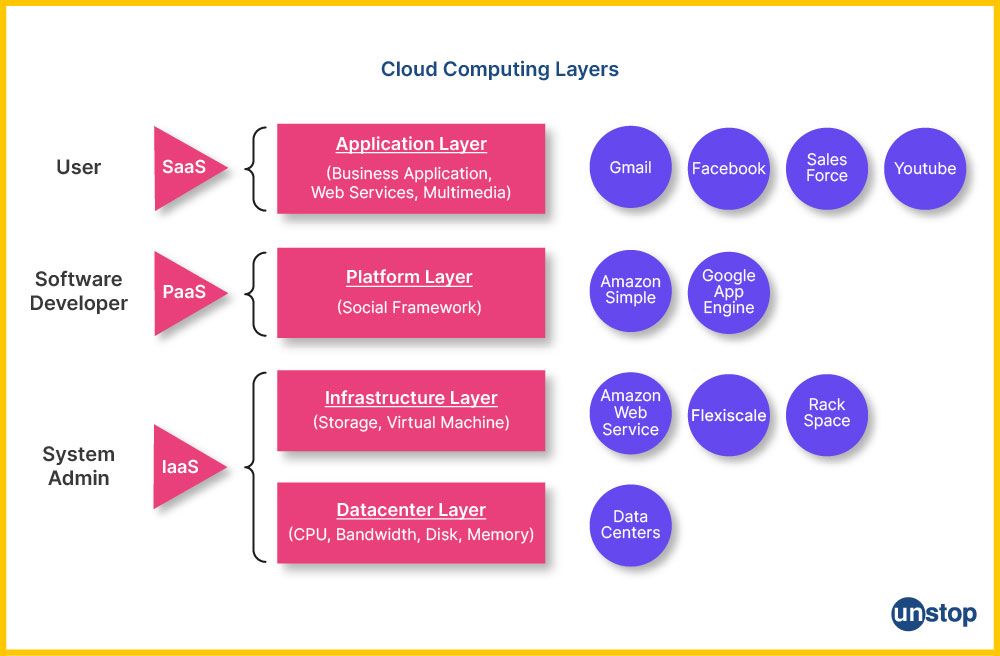
Cloud architecture is all about the arrangement of the materials that form the environment for cloud computing platforms. It combines SOA (Service Oriented Architecture) and EDA (Event Driven Architecture). In the back end, cloud service providers provide resources, services, data storage, and applications. Using a network, data can be transported between front-end and back-end cloud architecture components. The service model determines how the communication will take place.
This means that cloud computing enables users to utilize remote computing resources on demand, including servers, storage, databases, networking, software, analytics, and intelligence through the internet rather than possessing such amenities at their locality.
Thus, whenever a user interacts with the front end (or client-side interface) of the cloud computing architecture, it sends queries to the back end, where the service model executes the specific request.
Cloud computing is a dynamic approach for offering computation resources utilizing the web. On-demand users access and use resources which reduce costs and enhance efficiency. This specific implementation might differ for each service model or a chosen cloud provider.
Front-End Platform
The front-end platform functions as the channel through which users transact the cloud, offering an avenue for running apps, storing data, and managing computing resources. It makes the complexity of the backend infrastructure abstract, thus giving end users an easy-to-use application that does not require deep technical knowledge to exploit the benefits of using a cloud platform.
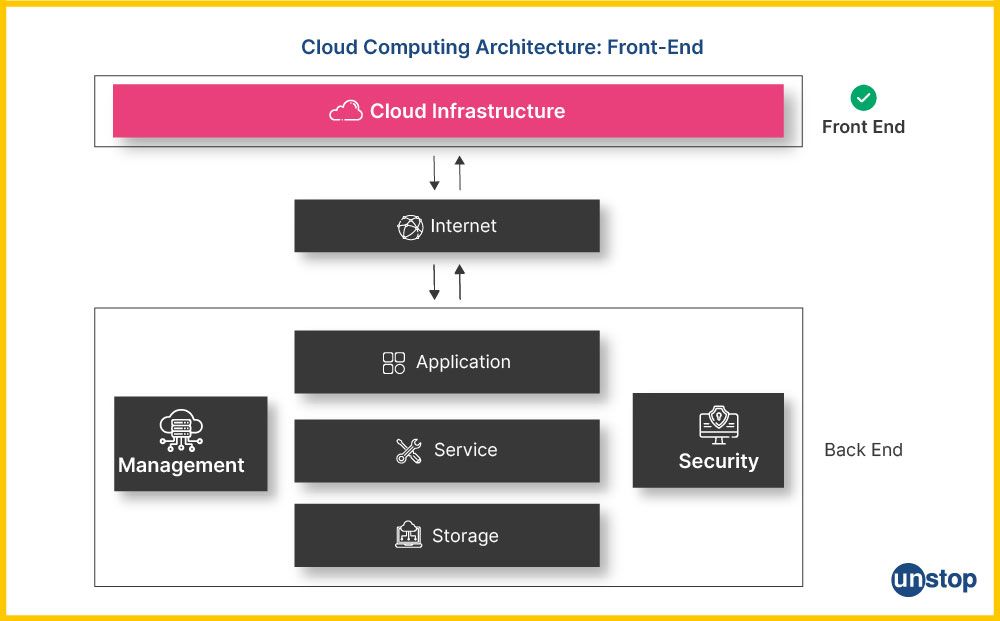
Here's an explanation of its meaning and purpose, along with its key components:
User Interface (UI):
- Meaning: The UI forms the visual and interactive interface that the end-users use to access and manage the cloud services. This involves dashboards, control panels, and a graphical user interface.
- Purpose: The UI ensures that users can easily access and manage the available resources within the cloud. It lets users apply, keep track of, and manipulate apps and information without thinking about the intricacies of the in-built front-end infrastructure.
Client Infrastructure (Software and Hardware):
- Meaning: Client infrastructure can refer to either the software or hardware aspect of an end-user device that accesses the cloud. These comprise equipment such as smartphones, desktops, etc.
- Purpose:
- Software Components: The software installed on the client side provides compatibility and inter-communication with the cloud service provider. They may include web browsers, cloud management software, or other tools that aid user interaction.
- Hardware Components: Users can connect to cloud services through hardware, including mobile devices and computers. These devices have a bearing on the overall user experience through their processor capacity, memory, and connectivity capability.
Connection to Other Components:
The front-end platform is the face of cloud services to users. The structure offers an intuitive interface among the front and back end, ensuring an effective use of the cloud services. It works with other backend parts like servers, storage devices, and networks to achieve a smooth flow of information and efficient data exchange. It's instrumental in providing security features, ensuring compliance with safety wishes, and heading off associated risks accompanying person interplay.
Back-End Platform
The back-end platform constitutes the core infrastructure and services that power cloud computing. Its purpose is to handle the processing, storage, and management of data and applications, ensuring the seamless delivery of services to users while maintaining security, scalability, and reliability. As the major pillar in cloud architecture, the back-end performs workloads that a user does not directly experience.
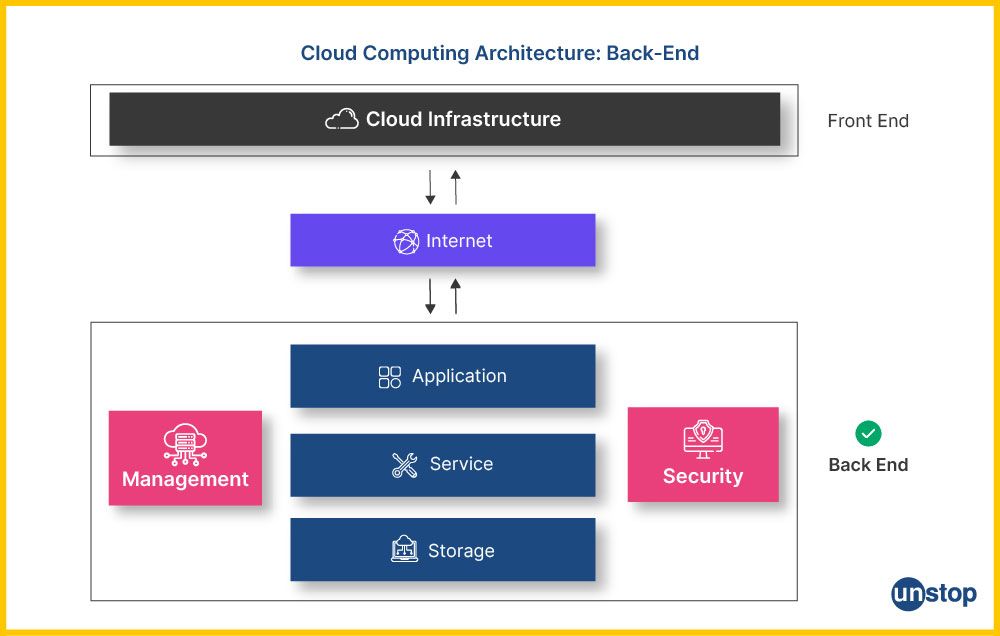
Here's an explanation of its meaning, purpose, and critical components:
Application Components:
- Meaning: The software and service apps providing execution or management of applications within the cloud infrastructure environment.
- Purpose: These work to enhance application deployment, scaling up, and regular maintenance, so users can avail of a smooth service.
Runtime Environment/ Runtime Cloud:
- Meaning: This comprises the runtime environment, the infrastructure in which applications are executed together with the required software, libraries, etc.
- Purpose: It enables running applications with necessary resources and runtime support, efficient performance optimization, and minimization of utilized resources.
Storage Components:
- Meaning: Cloud storage components are infrastructure and services used for saving and governing data in the cloud.
- Purpose: They make sure that information is persistent, available, and scalable for convenient storage and retrieval by users.
Traffic Control Mechanisms:
- Meaning: Data flow traffic control mechanisms are embedded into the back-end infrastructure to improve performance and deliver effective messaging.
- Purpose: These applications increase speed, decrease latency, and improve allocation processes for different job queues.
Security Mechanisms:
- Meaning: Security mechanisms in the back-end platform include features such as secure cloud resources, logical servers, and stringent data security measures.
- Purpose: They safeguard the integrity, confidentiality, and availability of facts and programs, addressing protection issues and dangers of cloud computing.
Networking Infrastructure:
- Meaning: Networking infrastructure refers to the technology components responsible for establishing communication between different elements of the back-end and the front-end.
- Purpose: It enables seamless data transfer, server communication, and connectivity with the front-end platform and client devices.
Cloud Storage:
- Meaning: Cloud storage is a specific component of the back-end platform dedicated to storing and managing data in a scalable and distributed manner.
- Purpose: It provides storage resources and space, offering flexibility and scalability for handling diverse data storage requirements.
Cloud Provider:
- Meaning: The cloud provider is an entity that offers cloud services, managing and maintaining the back-end cloud infrastructure.
- Purpose: Cloud providers deliver computing resources, including servers, storage, and networking, allowing users to leverage cloud services without needing extensive on-premises infrastructure.
Types of Cloud Computing Architecture
The three main types of cloud architecture are:
Public Cloud Architecture: It is a cloud computing system whose resources, such as computers, are shared on the Internet by different users. Third-party cloud service providers control and manage these services that are open to the public. Public cloud architecture provides scalable and flexible computing resources.
Example - Amazon’s web services (AWS): AWS is one of the major players in the market of public cloud users. The AWS Public Cloud Solutions include virtual servers, virtually all scalable computer resources, such as VDS, storage and database, addressed to various users from all over the world.
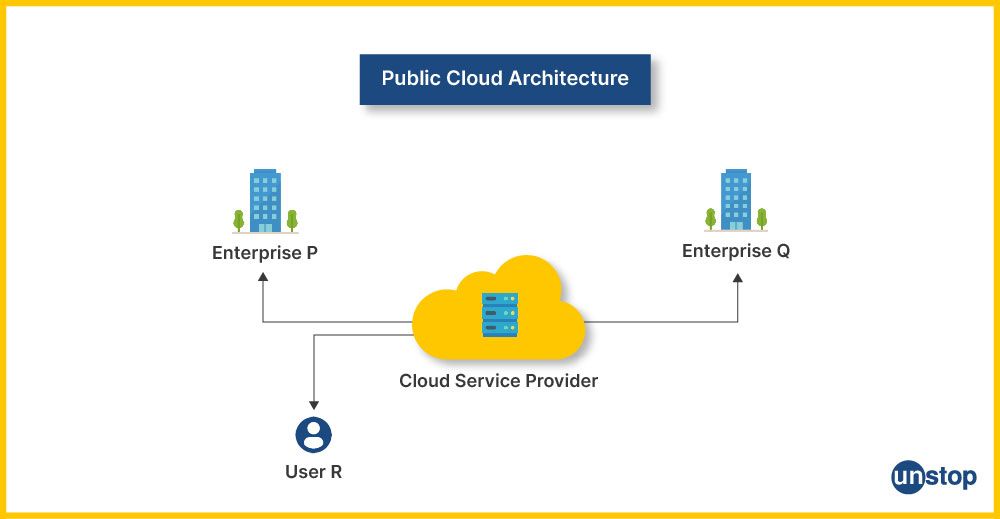
Private Cloud Architecture: A private cloud architecture means an organization-centric cloud infrastructure. Enhanced control, security, and customization are provided over most of these systems, usually in-house or outsourced.
Example - Azure Stack: Organizations can build their private cloud environment using the Azure cloud technology known as Azure Stack. This enables organizations to run a private cloud on their site, preserve total data commands, and meet particular security requirements.
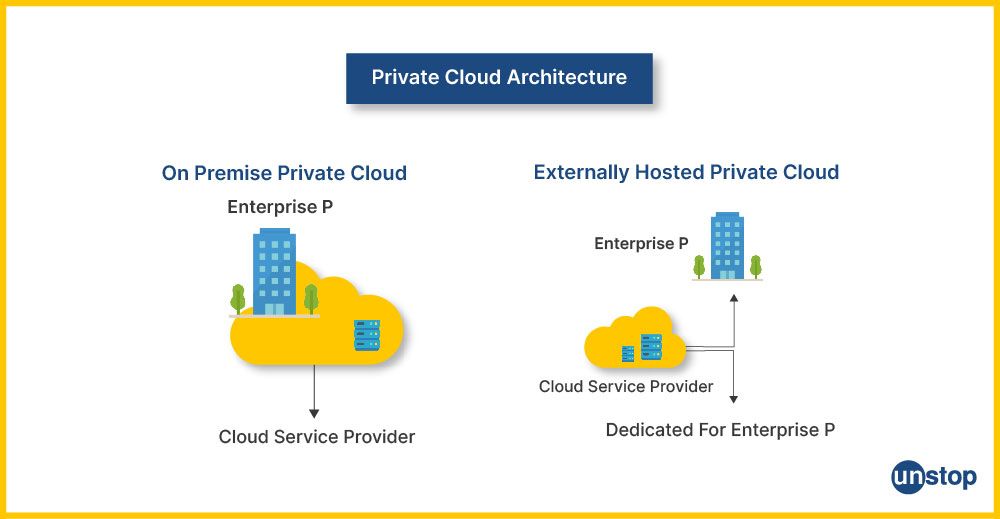
Hybrid Cloud Architecture: A hybrid cloud architecture that incorporates both public and private cloud environments so that data and apps can be shared between them. This opens up more flexibility and scalability for organizations, leading to utilizing both types of deployments.
Example - Google Anthos: Organizations can easily create, upload, and govern applications across premises and different clouds like Google Cloud Platform (GCP), AWS, and Azure.
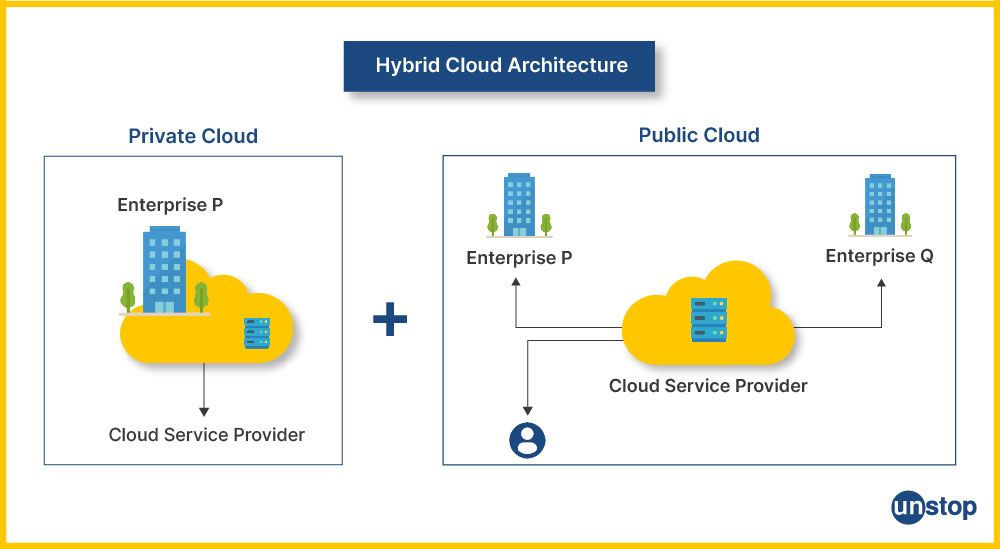
Benefits of Cloud Computing Architecture
The key benefits of cloud computing architecture include:
- Scalability: Cloud architecture allows for seamless scaling of computing resources, enabling businesses to adapt to changing workloads and demands quickly.
- Cost Efficiency: Cloud computing offers a cost-effective model where organizations pay only for the resources they use, reducing the need for substantial upfront investments in physical infrastructure.
- Flexibility and Adaptability: Cloud architecture provides flexibility by offering different deployment models (public, private, hybrid) to suit varied organizational needs and adapt to evolving business requirements.
- Resource Optimization: Efficient utilization of resources is achieved through features like virtualization technology, ensuring that computing power and storage are used effectively, minimizing wastage.
- Rapid Deployment: Cloud computing allows for the quick deployment of applications and services, reducing the time-to-market for new products and initiatives.
- Enhanced Security Capabilities: Cloud providers implement robust security measures, including stringent data security, virtual firewalls, and secure cloud resources, ensuring the protection of sensitive information.
- Reliability and Availability: Cloud architecture is designed for high availability, with redundant systems and data backup strategies, minimizing downtime and ensuring reliable service delivery.
- Business Continuity and Disaster Recovery: Cloud computing supports effective disaster recovery and business continuity planning, offering backup and recovery solutions to safeguard data during unforeseen events.
- Innovation and Digital Transformation: Cloud computing facilitates digital transformation by providing a foundation for innovative technologies like artificial intelligence, machine learning, and event-driven architecture.
- Streamlined Operations: Cloud-based delivery services simplify computing systems, making operations more efficient, reducing complexity, and enabling organizations to focus on their core competencies.
- Multi-Cloud and Hybrid Flexibility: Businesses can leverage a multi-cloud or hybrid cloud environment approach, combining different cloud providers or environments to optimize performance and meet specific needs.
- Client Requirement Customization: Cloud computing allows organizations to customize services based on client requirements, ensuring that solutions align with business goals and objectives.
- Improved Collaboration: Cloud-based applications and storage facilitate enhanced collaboration, allowing teams to work on documents and projects in real-time from different locations.
- Environmental Sustainability: Cloud computing contributes to environmental sustainability by optimizing resource usage, reducing the need for physical servers, and promoting energy efficiency in data centers.
It's also important to be aware of the disadvantages of cloud computing, namely potential security risks, dependence on internet connectivity, limited control over infrastructure, possible downtime, and ongoing costs.
Conclusion
Modern technological infrastructure is primarily built on cloud computing architecture, which revolves around business activities and how people relate to digital resources. Hardware, software, networking, and services form this structured architecture of cloud computing technology.
The triumvirate of public, private, and hybrid cloud architectures offers organizations a spectrum of choices, exemplified by industry giants like AWS, Azure Stack, and Google Anthos. Each type caters to distinct needs, providing scalability, security, and flexibility.
Finally, cloud computing architecture surpasses conventional approaches that provide an agile, economical, and scalable platform. It acts as a chain in business chain adaption to the new age of improved efficiency, innovation, and a secure future.
Frequently Asked Questions (FAQs)
1. What is the fundamental structure of cloud computing, and how does it operate?
Cloud computing architecture refers to the organizational framework of elements within a cloud, comprising hardware, software programs, networking, and offerings. It offers on-demand access to computing resources. The front-end offers consumer interfaces, while the lower back-end consists of servers, garages, and networks. Users get entry to resources like digital machines and programs without needing bodily hardware infrastructure.
2. How does cloud computing architecture enhance business benefits and operational efficiency?
Cloud computing architecture offers several commercial enterprise advantages, like scalability, cost saving, and versatility. It optimizes operating fees by allowing corporations to pay for assets they use. The computing device becomes easier as cloud offerings deal with backend complexities.
3. What security measures are integrated into cloud computing architecture, and what are the associated risks?
Security is one of the key components in the cloud computing strategy. Protection mechanisms like virtual firewalls and strong data protection with reliable cloud sourcing are in place. Nevertheless, risks such as the breach of capability profiles, illegal entrance, and compliance demands exist. Robust architecture with encryption techniques and continuous monitoring are integral when dealing with safety risks. Acceptable practices and security measures play a significant role in minimizing ability risks in Cloud Computing systems.
4. What is the architecture of cloud computing, and how does it differ from traditional computing fashions?
Cloud computing structure or architecture refers to the structural agency of factors inside a cloud setting, encompassing hardware, software, networking, and services. Unlike traditional computing, cloud structure allows on-call access to computing assets, with the front-end managing user interfaces, the back-end managing infrastructure, and various cloud deployment models catering to multiple wishes.
5. What are the key advantages of deploying packages through cloud-primarily based services?
Deploying packages through cloud-based total offerings gives numerous blessings. It simplifies the operating system, making the computing system extra handy and value-green. The flexibility feature of cloud computing permits useful resource sharing, allowing businesses to scale their infrastructure based totally on demand. Moreover, cloud-based services decorate collaboration via consumer-pleasant patron-side interfaces and offer entry to digital gear for streamlined operations.
6. How does cloud computing impact cost minimization?
Cloud computing architecture enables corporations to optimize prices through a pay-as-you-go model. With sources available on call, organizations can scale infrastructure based on present-day desires, eliminating the want for full-size premature investments. This flexibility makes computing gadgets easier, reducing operating fees by ensuring efficient, helpful resource usage.
7. Discuss the importance of front-end cloud architecture and back-end cloud architecture components in facilitating smooth client interaction.
Cloud computing front-end architecture embraces consumer and client-face interfaces with user-friendly viewpoints of cloud computing services. On the other hand, the back-end architecture comprises servers, storage, and networking so that any service is delivered upon request. This integrated structure makes it impossible to interrupt consumer enjoyment as customers only interact with a platform's simple front-end without getting involved with complex back-ends.
Suggested Reads:
I’m a reader first and a writer second, constantly diving into the world of content. If I’m not writing or reading, I like watching movies and dreaming of a life by the beach.
Login to continue reading
And access exclusive content, personalized recommendations, and career-boosting opportunities.
Subscribe
to our newsletter
















Comments
Add comment